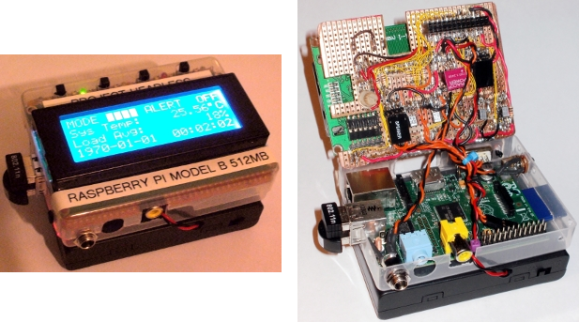
[Jason Birch] just finished building a beautifully simple user interface for the Raspberry Pi. The goal was to keep it small and intuitive while still providing a range of functionality. His add-on hardware gives feedback using several LEDs and a four-line character LCD screen. It provides control using just four momentary press switches.
The base for the add-on hardware is a chunk of protoboard the same size as the Pi itself. This is just slightly wider than the LCD screen, leaving room along the top for the row of buttons with different colors of LEDs in between them. Look closely in that nest of point-to-point wiring and you’ll find the dual pin-socket which mates with the RPi GPIO header. One important note from [Jason] mentions that the LCD screen R/W pin must be tied to ground. This keeps it from going into read mode, which would push 5V over the I/O pins, potentially damaging the 3.3V tolerant header on the RPi.
Throw in a battery and that pretty much covers the hardware. To see how he’s using it you’ll want to view the video clip after the break.
[Thanks Tom]















Reblogged this on Julio Della Flora.
All I see is LCDproc running. Absolutely all of that can be done with LCDproc.
Could you help me out? I downloaded and ran LCDproc, but it’s not making an LCD appear out of nowhere and attaching it to my pi with a protoboard…
Any expanding of details for your directions would be most helpful
I like this, because I’m doing the same thing, so its great to see another’s take on the same idea. One difference, is that I drive the backlight led using the only available pwm pin, and this allows me to control the brightness of the display in software. I too included a TTY, but I used a max232 board off eBay.
Please put an little color touch screen and kickstart it now! I would be buy it for sure.
How does he cut the power after the shutdown command is issued? There’s nothing on the project webpage, and I don’t see him switching the battery pack off at the end of the video.
I suppose he might just be cutting the power to the LCD and backlight, and leaving it to the user to turn off the battery pack anyway.
You can buy the LCD-and-buttons as the “RPI_UI” at BitWizard: http://www.bitwizard.nl/catalog/product_info.php?cPath=34&products_id=115
Chose 16×2 or 20×4 for the LCD and choose wether you want to address the functions over SPI or I2C…. Then concentrate on the software, or nag Jason for his software….